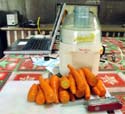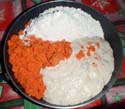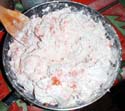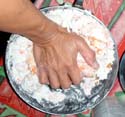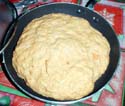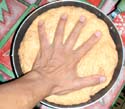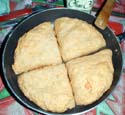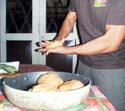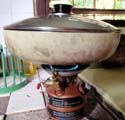 Mar 5, 2011
Mar 5, 2011
Stovetop Carrot Bread
After-Juicing Dilemma
Ever since I started juicing veggies, mostly carrots, I've always wondered what creative use I can have for the left-over pulp. Usually, specially with commercial juicing kiosks, it's simply thrown away. But hey...that's still good food! I've found creative uses for the pulp since then, the most useful is making carrot bread. The pulp acts as a flour extender and also provides lots of fiber, flavor and nutrition. Since you're using the stove, you save on power compared to baking it in an oven.
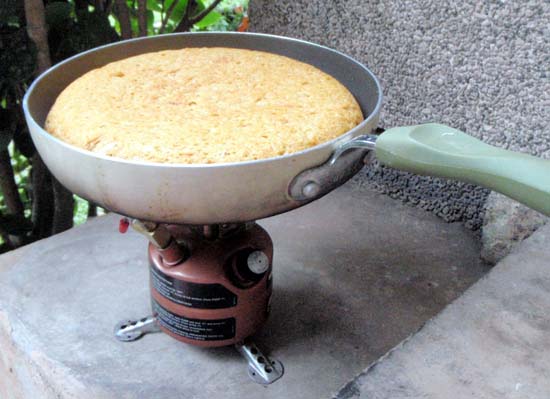
Other Creative Uses of Carrot Pulp
- tomato sauce thickener - normally, when you make tomato sauce from scratch, you dump tons of fresh tomatoes on the pot and continue simmering to reduce. Not anymore. Once it simmers, just add enough carrot pulp to the desired consistency...and you're done! The taste is interesting too. Tomato and carrot taste blend seamlessly!
- yogurt drink thickener - I add it to my drinkable yogurt and it's instantly thick yogurt...like making thin milkshake into a thick milkshake. Again carrot taste blends well with just about any yogurt flavor I've used.
- omelette thickener - cowboy style!
- chicken feed - yeah, just discovered that. Chickens didn't know what to do of it until one tried it. The rest followed. The pulp was gone in no time!
Carrot Bread Recipe
Utensils Needed
- juicer. If you don't have one, you can simply grate the carrots finely
- whisk
- pot with cover (glass cover is best)
Ingredients: (makes a decent size loaf)
- 1/2 kilo carrots
- 3 cups flour
- 1 tbsp yeast
- 3/4 warm water
- 1 tbsp brown sugar
- 1 cup carrot pulp
- 1 tsp salt
- 3 tbsp oil
- 1/4 cup raisins
- pour water into the pot, sugar, 1 cup flour and yeast, in that order. Whisk until smooth. This is your sponge. Cover until size doubles and bubbles start forming. This is the first rising.
- add 1 tbsp oil, salt, 2 cups flour and carrot pulp. Mix and then start kneading (new to kneading? check out this link). You're done kneading when the dough returns to its shape after pressing your finger into it (although I've seen videos saying the complete opposite - that you're done kneading when the indentation remains!). Shape into a ball, put back into pot, pour another 1 tbsp of oil on top, and cover pot. Wait until dough doubles in size. This is the second rising.
- press the expanded dough with your palm to release the gas and flatten the dough. Divide into quarters. Roll one quarter at a time with your 2 hands. When you roll, you're doing 2 things at the same time - you're shaping the dough into a ball AND you're also applying pressure as you roll so that whatever air inside the dough is pushed out. Repeat with the other quarters.
- you can freeze the other quarters you won't be needing. The ones you'll be cooking (I can't use the word baking), shape it into your own style - rounded flat like pita bread, or balled like a loaf. Put back in the pot and cover until double in size. This is the third and final rising.
- over low medium heat, put the pot directly on the stove. If you're using all the quarters, around 15 mins one side, covered.
- Turn the dough over to cook the other side...another 15 minutes, covered. Release the cover on the last 5 minutes so that the top is crunchy. Tap into the dough with your fingernail. If it sounds hollow, it's done.
- put the bread on a wire rack so that the underside breathes and don't get soggy. Bread continues to cook even with no heat, so wait about 5 minutes before you eat it.
- bon appetite!
Tips
- when kneading, you may have to add water or flour to make the right consistency. This is the difficult part because carrot pulp has a varying amount of water it in, depending on the juicer. The rule is, the dough has to be as soft as possible without being sticky.
- for the third rising, shape the dough so that it doesn't touch the pot cover when it expands. If you're using a frying pan like me, I have no choice but to shape it low and broad.
- best to use a pot with a glass cover so you see if the dough has doubled in size
Verdict
With a nice dip like olive oil/balsamic vinegar, chilled Chardonnay (or in my case, any cheap white wine), it's a stand-alone meal that measures up to any epicurean benchmark.
--- Gigit (TheLoneRider)
YOGA by Gigit ![]() |
Learn English
|
Learn English ![]() |
Travel like a Nomad
|
Travel like a Nomad ![]() |
Donation Bank
|
Donation Bank ![]()
Reader Comments:
 Ronx
Ronx (Mar 6, 2011) Interesting. 🙂 I'm a loser when it comes to cooking. Hopefully with the step-by-step guide your blog might jumpstart my interest in cooking! 🙂
 Andrew
Andrew (Mar 5, 2011) ...thanks for the step-by-step with photos and all.
 Abesamis Family
Abesamis Family(Mar 5, 2011) Great bread! We had it for breakfast and we're snacking on it now!
Next stop: The Lamborghini Benchmark
Currency Converter
»» next story: The Lamborghini Benchmark
»» next Recipe: Smoked Mamsa with Bearnaise Sauce
»» back to Recipes
»» back to Homepage
ARCHIVE 2025:
JAN |
FEB |
MAR
1970 |
1973 |
1975 |
1976 |
1977 |
1979 |
1981 |
1996 |
2000 |
2001 |
2002 |
2003 |
2004 |
2005 |
2006 |
2007 |
2008 |
2009 |
2010 |
2011 |
2012 |
2013 |
2014 |
2015 |
2016 |
2017 |
2018 |
2019 |
2020 |
2021 |
2022 |
2023 |
2024 |
2025 |
ALL BLOGS
